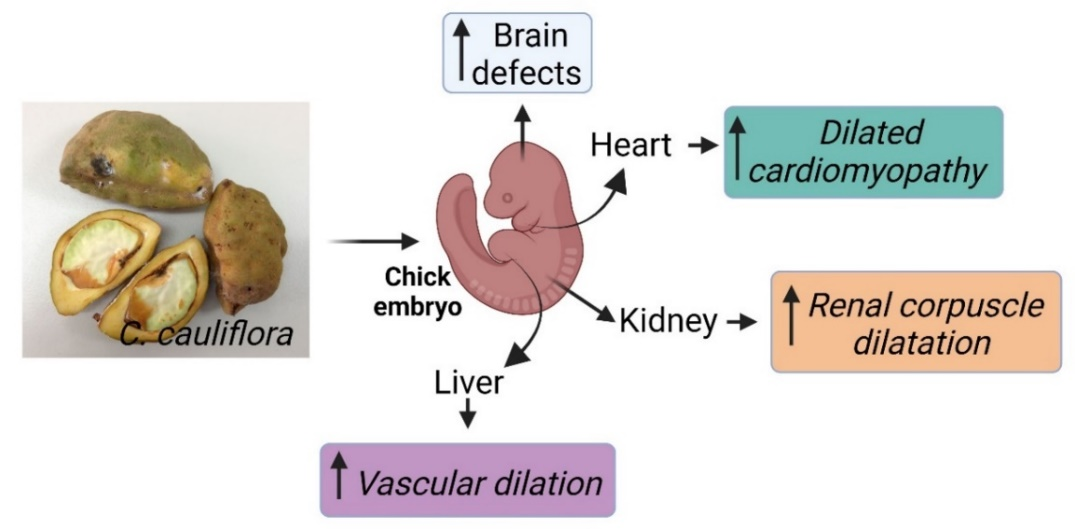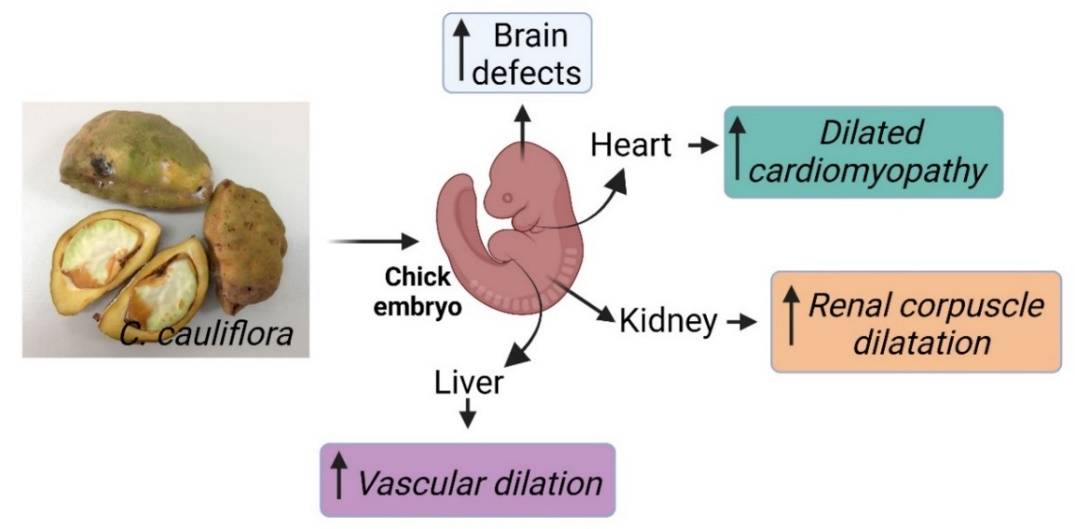The Effect of Cynometra cauliflora Linn. Fruit Extract-Induced Congenital Anomalies on Chick Embryos
DOI:
https://doi.org/10.48048/tis.2024.7454Keywords:
Cynometra cauliflora, Birth defects, Chick embryo, Traditional medicine, Pregnant womenAbstract
Background: Cynometra cauliflora is a traditional folk medicine that is used to treat a variety of unpleasant symptoms without adverse effects. Previous studies have shown that C. cauliflora fruit relieving morning sickness and nausea in pregnant women. However, no research has been performed on the effect of C. cauliflora fruit extract on birth anomalies. Objective: In this study, we aim to investigate the effects of C. cauliflora fruit extract on developing chick embryos. Materials and Methods: Three hundred fertilized eggs were divided into 2 groups; 1) the experimental groups received various doses of C. cauliflora fruit extract at 50, 100, 200, and 400 mg/kg, and 2) the control group received a 0.9 % normal saline solution. One hundred and fifty eggs at embryonic day-3 (ED-3) were observed for LC50, morphology, and histology, while the 150 eggs at embryonic day-6 (ED-6) were investigated for morphology and histology. Results: At a dosage of 291.70 mg/kg, the C. cauliflora fruit extract induced mortality in ED-3 by more than 50 %. Moreover, fruit extraction can also result in anomalies in ED-3 and ED-6, such as anterior neuropore openings, heart tubes, liver and kidney tissue defects. Conclusion: As a result, it was determined that tissue damage and organ malformation followed dose-dependent and all-or-none laws. Despite having a wide range of medical properties, C. cauliflora fruit extracts have been demonstrated to impair early growth and development and cause birth abnormalities in animal studies. This will allow further determination of regulatory criteria for medical use, particularly for pregnant women.
HIGHLIGHTS
- First report of the cauliflora fruit extract induced embryonic lethality
- The cauliflora fruit extract induces embryonic organ and tissue anomalies following dose-dependent and all-or-none laws
- These experimental protocols are beneficial for teratogenesis studies
GRAPHICAL ABSTRACT

Downloads
Metrics
References
BB Petrovska. Historical review of medicinal plants’ usage. Phcog. Rev. 2012; 6, 1-5.
NZA Wahab, A Azizul, N Badya and N Ibrahim. Antiviral activity of an extract from leaves of the tropical plant Cynometra cauliflora. Phcog. J. 2021; 13, 752-7.
S Sabiha, R Serrano, K Hasan, IBMD Silva, J Rocha, N Islam and O Silva. The genus cynometra: A review of ethnomedicine, chemical, and biological data. Plants 2022; 11, 3504.
G Gachelin, P Garner, E Ferroni, U Tröhler and I Chalmers. Evaluating Cinchona bark and quinine for treating and preventing malaria. J. Roy. Soc. Med. 2017; 110, 31-40.
BA Samling, Z Assim, WY Tong, CR Leong, SA Rashid, NNSNM Kamal and WN Tan. Cynometra cauliflora L.: An indigenous tropical fruit tree in Malaysia bearing essential oils and their biological activities. Arabian J. Chem. 2021; 14, 103302.
SAT T-Johari, N Mat, AB Siti-Aishah, AAM Yusran, A Alwi and AM Ali. Cytotoxicity, antiproliferative effects, and apoptosis induction of methanolic extract of Cynometra cauliflora Linn. whole fruit on human promyelocytic leukemia HL-60 cells. Evid. Base. Compl. Alternative Med. 2012; 2012, 127373.
TK Lim. Edible medicinal and non-medicinal plants. Springer Dordrecht, Dordrecht, Netherlands, 2012.
A Aziz, A Farina and I Mohammad. Antioxidant activity and phytochemical composition of Cynometra cauliflora. J. Exp. Integr. Med. 2013; 3, 337-41.
Nurbidayah, Nafila, N Amalia. Antibacterial activity of Namnam fruit juice from South Kalimantan against staphylococcus aureus and Escherichia coli. J. Vocat. Health Stud. 2023; 7, 48-54.
A Seyedan, Z Mohamed, MA Alshagga, S Koosha and MA Alshawsh. Cynometra cauliflora Linn. Attenuates metabolic abnormalities in high-fat diet-induced obese mice. J. Ethnopharmacol. 2019; 236, 173-82.
MA Ado, A Mediani, ISM Ismail, HM Ghazali and F Abas. Flavonoids from Cynometra cauliflora and their antioxidant, α-glucosidase, and cholinesterase inhibitory activities. Chem. Nat. 2019; 55, 112-4.
CW Ong, YS Chan, KS Khoo, HC Ong and NW Sit. Antifungal and cytotoxic activities of extracts obtained from underutilised edible tropical fruits. Asian Pac. J. Trop. Biomed. 2018; 8, 313.
S Anliza and N Rachmawati. Cytotoxic activity of ethanol extract in namnam leaves (cynometra cauliflora l.) to hela cell. Walisongo J. Chem. 2021; 4, 107-12.
J Roongruangchai, Y Viravud, V Plakornkul, K Sripaoraya, W Boonmark and K Roongruangchai. The teratogenic effects of monosodium glutamate (MSG) on the development of chick embryos. Siriraj Med. J. 2018; 70, 514-22.
KA Wojtunik-Kulesza. Toxicity of selected monoterpenes and essential oils rich in these compounds. Molecules 2022; 27, 1716.
N Bernstein, M Akram, Z Yaniv‐Bachrach and M Daniyal. Is it safe to consume traditional medicinal plants during pregnancy? Phytother. Res. 2021; 35, 1908-24.
NS Dosoky and WN Setzer. Maternal reproductive toxicity of some essential oils and their constituents. Int. J. Mol. Sci. 2021; 22, 2380.
B Sarecka-Hujar and B Szulc-Musioł. Herbal medicines-are they effective and safe during pregnancy. Pharmaceutics 2022; 14, 171.
J Männer, W Seidl, F Heinicke and H Hesse. Teratogenic effects of suramin on the chick embryo. Anat. Embryol. 2003; 206, 229-37.

Downloads
Published
How to Cite
Issue
Section
License
Copyright (c) 2023 Walailak University

This work is licensed under a Creative Commons Attribution-NonCommercial-NoDerivatives 4.0 International License.






